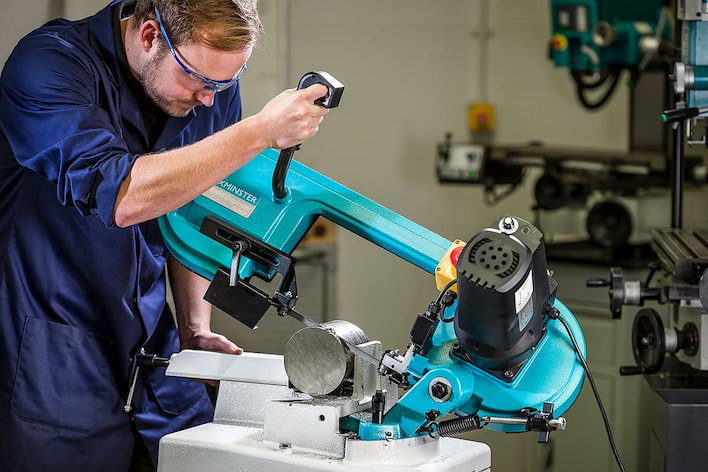Industrial machinery is often big bulky and extremely heavy but that’s not always the case as one good example of the opposite being true is a bandsaw. Although bandsaws aren’t anything portable they are still not as heavy as some other types of industrial machinery.
In fact, they come with a thin blade placed between two rotating mechanisms that allow them to cut through almost anything. This blade, although it may look fragile, it’s actually able to cut some of the toughest metals. The versatility of a bandsaw allows you to cut metals in any shape you want as long as you’re using the right type of blade and machine too.

Types of Metal Bandsaw Machines
Vertical
The most commonly used bandsaw machines nowadays are vertical bandsaws. As their name suggests these have the blade run vertically from the top down in order to cut through the workpiece. The main benefit of a vertical bandsaw machine is that it’s able to fit in any workshop as it’s quite a lot smaller than most other bandsaws.
Horizontal
With horizontal structural bandsaws, you can expect a more refined solution when it comes to cutting I-beams, pipes and angles. That’s because this type of metal band saw comes with an angled head, tall vise and a wider capacity than a vertical bandsaw. Most horizontal structural saws come with auto shuttling and a powered conveyor system.
Double-Column
Similar to a horizontal structural bandsaw, a double-column saw is a more robust option that allows you to create more intricate details. That’s because double-column or dual-column bandsaws have the entire sawing system lower and raise as needed thanks to hydraulics and precision columns. With a double-column saw you get features such as auto mitering and shuttling as well as bundle clamping.
Pivot Style
Also known as general purpose, pivot-style bandsaws are a type of horizontal saw that offers more features and is more capable than a regular horizontal bandsaw. This involves the use of hydraulics to feed the head as well as features such as shuttling, bundle clamping and metering. For your occasional metal-cutting demands, a pivot-style metal bandsaw is the right way to go.
Table & Portal
A table and portal bandsaw is a type of dual-column saw that is able to do the same work just in a larger format. This means you can cut extremely large and heavy pieces of metal as well as pipes. The sawing system of this type of bandsaw works together with a powered roller feed system that moves all its large components.
Tube
These are speciality bandsaw machines that are used only for cutting different diameter piping and tubes. Also referred to as cut-off saws these are also a type of dual column saw but with a twist as it’s fully automated especially when it comes to making fine details.

Using a Metal Bandsaw Machine
Safety Tips
Before you start using a metal band saw of any kind you should always keep some things in mind. For instance, you should never have your hands close to the blade, especially while running. When you’re cutting a workpiece, make sure to let the blade get to its full speed before you start doing so. Use enough force to cut the metal piece and if small or irregular workpieces are used then use a board or a push stick to push it.
Familiarise
Getting to know the bandsaw machine you’re about to use is a good rule of thumb no matter how experienced you are. You should know where the stop and start switches are without the need to look. You should also know how to make certain adjustments without fiddling too much as this can help make the task safer and the tuning process much easier too.
Measure
Before you lay down the workpiece on the table you should first mark it. This involves measuring the size of the cuts you want to make and whether or not they’ll fit when the piece of metal is going through the machine. If you need to make straight cuts ensure that the width of the workpiece won’t increase the space between the blade and the column.
Speed
Once all the measurements have been made and your piecework has been marked correctly you can go ahead and set the speed of the bandsaw. A good rule of thumb is to use faster speeds with more malleable materials and lower speeds with stronger materials.
Feed
Feeding or pushing the workpiece through the machine is the last and probably most important part. This is where you get to make the cuts and whether or not the feeding process is done manually or with a power feeder you should have it aligned with the blade. Make the workplace go through in a smooth and consistent motion and clean the metal band saw of any residue and particles before you turn it off completely.
